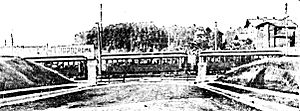Venice Short Line facts for kids
Quick facts for kids Venice Short Line |
|
|---|---|
| Overview | |
| Owner | Southern Pacific Railroad |
| Locale | Los Angeles |
| Termini | Subway Terminal Building Santa Monica, California |
| Stations | 19 |
| Service | |
| Type | Interurban |
| System | Pacific Electric |
| Operator(s) | Pacific Electric |
| History | |
| Opened | 1897 (to Vineyard) 1903 (to Venice) |
| Closed | December 28, 1950 |
| Technical | |
| Track gauge | 4 ft 8 1⁄2 in (1,435 mm) standard gauge |
| Old gauge | 3 ft 6 in (1,067 mm) |
| Electrification | 600 V DC Overhead lines |
The Venice Short Line was an important electric train line in Los Angeles. It was part of the Pacific Electric railway system. This line connected downtown Los Angeles to popular beach cities like Venice, Ocean Park, and Santa Monica. It mostly followed Venice Boulevard.
Contents
The Story of the Venice Short Line
The first part of this train line was built in 1897 by the Pasadena and Pacific Electric Railway Company. This section ran from Hill Street to a place called Vineyard. Later, in 1903, the Los Angeles-Pacific Railroad (LAP) built the rest of the line, extending it all the way to Venice.
In 1906, the Southern Pacific Railroad bought a big part of the LAP company. This led to a change in the train tracks. The distance between the rails, called the track gauge, was changed. It went from 42 inches (a bit wider than standard) to the standard gauge used by most trains today.
By 1911, the LAP company became part of the new Pacific Electric Railway. Pacific Electric operated the Venice Short Line for many years. However, train service on this line ended on December 28, 1950. After that, buses took over the route. By 1981, all the old train tracks had been removed or covered by pavement.
Where the Line Went
The Venice Short Line started in Downtown Los Angeles at the Subway Terminal Building. The famous Red Cars came out of the station onto Hill Street. The two train tracks ran south along Hill Street, crossing busy streets like 6th Street and Olympic Boulevard.

The tracks then turned west onto Venice Boulevard. For a long stretch, the tracks were in the middle of the paved street. They passed many major roads like Figueroa and Vermont. At Arlington Avenue, the tracks moved onto a special private area in the middle of the road, which was not paved. This private area ended at Crenshaw Boulevard.
After Crenshaw Boulevard, the tracks moved to the north side of Venice Boulevard, still on their own private path. They continued to Vineyard Avenue. This was an important spot because the Sawtelle Line branched off here, heading northwest towards Beverly Hills.
West of Vineyard Avenue, Venice Boulevard split into two roadways, with the train tracks running on their own private path in the middle. The Venice Short Line continued west, crossing over La Cienega Boulevard and passing the famous Helms Bakery.
The line then reached Culver Junction. Here, the Redondo Beach via Playa del Rey Line branched off to the southwest, and the Santa Monica Air Line crossed paths with the Venice Short Line.
From Culver Junction, the tracks continued west on their unpaved private path in the center of Venice Boulevard. They passed intersections like Sepulveda Boulevard and Lincoln Boulevard.
Finally, the line crossed the Grand Canal in Venice using a concrete bridge. After crossing, it turned north onto Pacific Avenue. The tracks ran on the street for a few blocks before entering a wide private area known as the "Trolleyway."
The line followed the "Trolleyway" north through Ocean Park. It passed the Ocean Park Carhouse, which was like a garage for the train cars. The "Trolleyway" ended at Pico Boulevard. From there, the tracks went back onto the street, following Ocean Avenue north. The Venice Short Line ended at Broadway in Santa Monica.
How the Trains Were Powered
The trains on the Venice Short Line got their electricity from the Ivy Substation. This substation provided 600 volts of direct current electricity through overhead lines, which the trains used to move.
The Trains Used
The Venice Short Line was one of the few Pacific Electric lines that used special trains called PCC streetcars. These modern-looking trains served the line for a short time, from February 1941 to April 1943.

